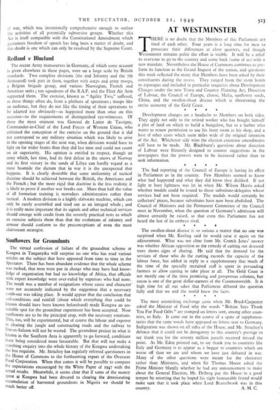Redland v Blueland
The recent Army manoeuvres in Germany, of which some account is given elsewhere in these pages, were on a large scale by British standards. Two complete divisions (the znd Infantry and the 7th Armoured) took part in them, together with corps and army troops, a Belgian brigade group, and various Norwegian, French and American units ; ten squadrons of the R.A.F. and the Fleet Air Arm supported them. The exercise, known as "Agility Two," suffered, as these things often do, from a plethora of spectators ; troops like an audience, but they do not like the timing of their operations to be adapted too obviously—as happened more than once on this occasion—to the requirements of distinguished eye-witnesses. Of these the most eminent was General de Lattre de Tassigny, Commander-in-Chief of the Land Forces of Western Union, who criticised the conception of the exercise on the ground that it did not correspond to any military situation which was likely to arise in the opening stages of the next war, when divisions would have to fight on far wider fronts than they did last time and could not count on air superiority. His opinion is entitled to respect, though an army which, last time, had its first defeat in the snows of Norway and its first victory in the sands of Libya can hardly regard as a mere bromide the dictum that in war it is the unexpected that happens. It is clearly desirable that some uniformity of tactical doctrine should be achieved between the British, the Americans and the French ; but the more rigid that doctrine is the less realistic it is likely to prove if another war breaks out. More than half the value of all formation training is nowadays administrative rather than tactical. A modern division is a highly elaborate machine, which can only be rarely assembled and tried out as an integral whole ; and it is really more important that its signals and other technical services should emerge with credit from the severely practical tests to which an exercise subjects them than that the evolutions of infantry and armour should conform to the preconceptions of even the most clairvoyant strategist.


































 Previous page
Previous page